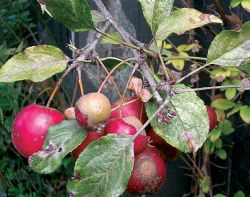Plant
Doctor Archive
Diseased
crab apple
  FOR
two years now I have had problems with my crab apple 'Jack Humm'.
Last year all the fruit became diseased after blossom time and eventually
dropped to the ground. I've attached a photo of what it looks like
at present. There is not a lot of air flow, as the tree is against
a 6ft-high fence. Does this contribute to the situation? FOR
two years now I have had problems with my crab apple 'Jack Humm'.
Last year all the fruit became diseased after blossom time and eventually
dropped to the ground. I've attached a photo of what it looks like
at present. There is not a lot of air flow, as the tree is against
a 6ft-high fence. Does this contribute to the situation?
 IT
looks as if your tree is suffering from a couple of fungus diseases.
The symptoms on the fruit look like apple scab, often called black
spot. The disease starts early in the season as spots on the leaves,
which look a different green from the rest of the leaf. The spots
gradually turn black and can get quite large. The fruit also gets
black spots that go brown and corky in the centre, sometimes with
cracks. The fungus overwinters on fallen leaves, with spores infecting
new growth the following spring. Cool, wet weather encourages the
disease. IT
looks as if your tree is suffering from a couple of fungus diseases.
The symptoms on the fruit look like apple scab, often called black
spot. The disease starts early in the season as spots on the leaves,
which look a different green from the rest of the leaf. The spots
gradually turn black and can get quite large. The fruit also gets
black spots that go brown and corky in the centre, sometimes with
cracks. The fungus overwinters on fallen leaves, with spores infecting
new growth the following spring. Cool, wet weather encourages the
disease.
The other disease that
could also be present is powdery mildew, which affects both leaves
and fruit. Encouraging better air flow around the tree could help,
but may not be practicable. Raking up the fallen leaves and fruit
in autumn would help reduce the chances of infection, but disease
spores could easily blow in from neighbouring gardens.
Spraying with fungicides
should help. In winter, after you've cleaned up fallen leaves and
fruit, give the tree a thorough spray with a copper-based fungicide,
such as Copper Oxychloride or Super Copper, or alternatively use
Lime Sulphur. Then, during spring, spray with a fungicide (Fungus
Fighter is good for black spot) every 10 days or so, starting from
just after the leaf buds open in spring until three weeks or so
after flowering has finished. This should protect the foliage and
young fruits from infection and, hopefully, lead to lovely clean
crab apples for next year's display.
You may find that following
this spraying programme for a year or two is enough to break the
cycle of infection and that you won't need to spray every year after
that. But it will depend a lot on whether there is a ready source
of infection from nearby gardens.
Weekend
Gardener, Issue 148, 2004, Page 26
Reproduced with permission from the former Weekend Gardener magazine. The views expressed here are not necessarily those of the RNZIH.
|
 |
 |
|